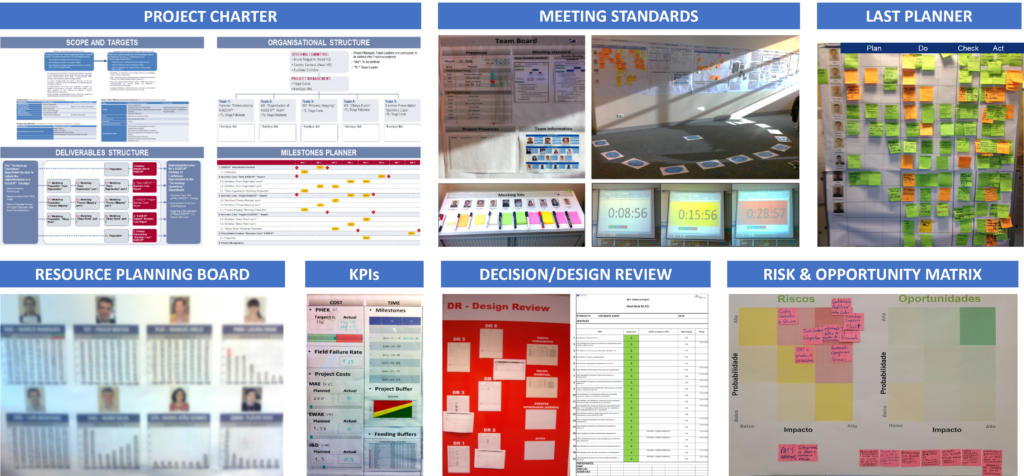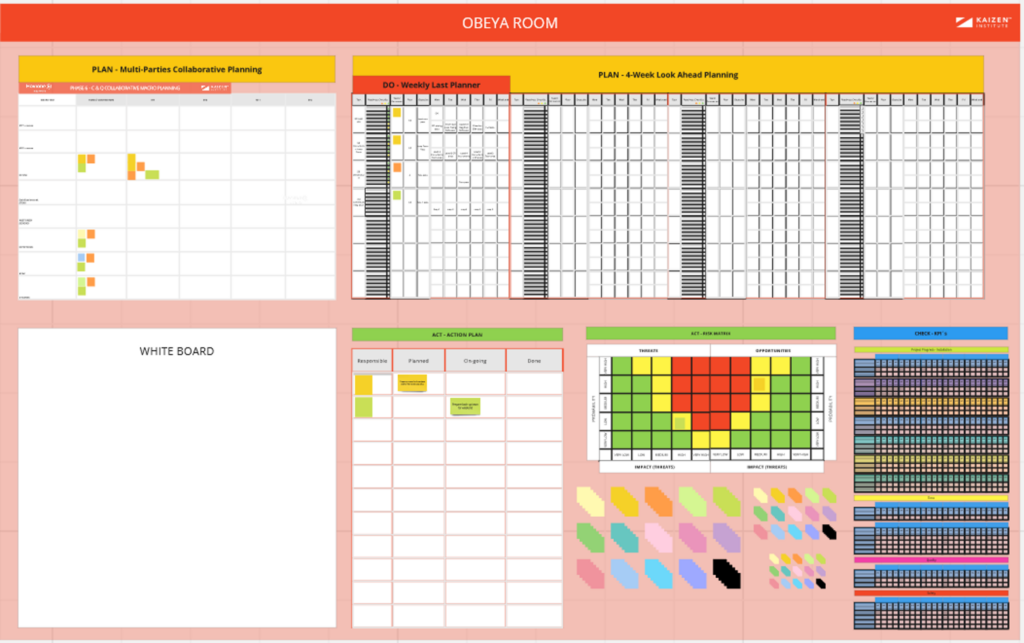In project management, the Obeya Control methodology supports coordination and collaboration optimization. This approach redefines how we conceive and conduct projects, gathering crucial information in the same place. Using a visual approach, ensuring regular and frequent updates, and filtering the level of detail to only the essentials, Obeya is not just a methodology; it’s a catalyst for simplification, transparency, and operational success.
Understanding the Essence of Obeya
Human understanding is linked to vision. Studies reveal that about 83% of the information we process comes from visual stimuli. Obeya acknowledges and capitalizes on this human preference for visual communication, creating an environment where teams from various functions and departments can absorb, understand, and interact with data more intuitively and effectively.
Visual Management in Obeya: Beyond Words and Numbers
Visual management in Obeya goes beyond displaying information; it is a language. Charts, diagrams, boards, color codes, and other visual elements represent project progress, identify risk areas, highlight achieved goals, and provide an instant overview of the project’s status. This visual approach simplifies communication and stimulates creativity and problem-solving, turning Obeya into a dynamic space.
Obeya as a Collaborative Space
The traditionally segmented nature of organizations, with different functions and departments, often leads to information silos and poor communication. Obeya, by creating a dedicated physical or virtual space, breaks down these barriers, providing an environment where members of various functions can meet, interact, and collaborate closely. This promotes a more holistic project understanding and stimulates a culture of collaboration, which is essential for overcoming complex challenges.
Benefits of Obeya Control
Obeya Control is an approach simplifying and improving project management, triggering a series of benefits. Let’s explore how implementing Obeya Control can revolutionize how projects are conducted, positively impacting various key areas.
- Project Management Simplification: By creating a visual and collaborative space that gathers all the essential information, from project plans to performance metrics, the Obeya approach eliminates unnecessary complexity. This helps to understand the project’s status and enables decision-making, allowing a quicker response to changes in the project.
- Decrease in Project Delivery Time: Implementing Obeya reduces project duration. By creating a unified view of all project phases, from concept to delivery, teams are empowered to identify bottlenecks and optimize processes.
- Improvement in Project Quality Control: By standardizing the project management process and defining standards for meetings with the project team and key stakeholders, it is possible to ensure the quality of work done and detect potential errors earlier.
- Increase in Resource Productivity: Teams can allocate resources more effectively by providing a comprehensive view of all tasks and responsibilities. On the other hand, the need for rework is eliminated by ensuring quality, which positively impacts team productivity and motivation.
- Promotion of Collaborative Work Across Functions: Obeya provides an environment conducive to collaboration, bringing together members from different functions in a dedicated space. This promotes the exchange of ideas, quick problem-solving, and the creation of synergies that drive the project more effectively.
In summary, Obeya Control goes beyond simplifying project management; it also redefines team dynamics and optimizes the process, resulting in faster, higher-quality delivery more aligned with customer expectations. This approach benefits various projects, from new product development projects to large capital projects like designing new factories or lines.
Obeya Elements
In the universe of Obeya Control, the physical or virtual space setup plays a primary role in its effectiveness. The size, focus, and type of project overlap to define the room’s content, creating an environment that enhances collaboration and visual management. Let’s explore the key elements that make up the Obeya space.
Project Charter and Project Design
In Obeya, the project’s objectives, scope, deliverables, and team should be present through the Project Charter. The Project Design, in turn, allows visualizing the phase-gate model where the project’s phases and critical decision points are represented.
Pull Planner and Last Planner
The Pull Planner and the Last Planner optimize task planning and execution. The Pull Planner allows for creating efficient workflows, while the Last Planner, whether in a 6-week or 1-week cycle, focuses on constant review and dynamic adaptation to ensure timely delivery.
Load/Capacity Management
The team’s load management should also be present in the Obeya space, giving visibility to the team members’ load and capacity in the short and medium term. This load map allows identifying problems of lack or excess load and making adjustments.
Meetings and Project Standards
Meetings, a fundamental part of Obeya Control, must be standardized – frequency, agenda, participants, etc. – to ensure efficiency and focus. These sessions promote open communication and provide a strategic discussion and decision-making platform.
Key Performance Indicators (KPIs)
From team performance to project indicators, the Obeya space embraces transparency through visual indicators. The indicators provide a transparent view of progress, quality, costs, and other relevant topics, allowing real-time adjustments to achieve goals.
Design/Decision Reviews and Project Standards
The contents of Design/Decision Reviews and project standards are included in the Obeya space to ensure quality and consistency throughout all phases. The focus on quality elevates the project’s outcome and ensures that, when necessary, standards are updated for the success of future projects.
Risk and Opportunity Matrix
Risk management is central to the project’s success, and the Obeya space should include a dedicated matrix to visualize and mitigate risks and identify strategic opportunities to be considered.
Issues and Kanban 3C
Obeya Control incorporates an agile Kanban 3C system (Case, Cause, Countermeasure) to monitor and manage issues, ensuring a structured and efficient approach to resolving critical issues.

These are just a few examples of the elements in an Obeya space. The combination of these components creates an environment where the complexity of project management is simplified, allowing for a unified view, efficient collaboration, and informed decision-making.
Types of Meetings in the Obeya Space
Effective meeting management plays a crucial role in successfully implementing Obeya Control. Different types of meetings are defined to meet specific needs and ensure team members are continually aligned. Let’s explore the main types of meetings in Obeya and understand how each contributes to efficient project management.
Gate Meeting: Decision Making and Design Evaluation
The Gate Meeting is a crucial milestone in the project lifecycle and consists of strategic decision-making, i.e., “go/no-go” for each critical phase. With an intense focus on design review or relevant decisions and based on a standardized checklist, this meeting ensures the timely delivery of important milestones. The emphasis on early document sharing ensures greater review efficiency and facilitates decision-making agility.
Weekly Obeya Meeting: Continuous Monitoring and Strategic Planning
Weekly Obeya meetings are the backbone of the process, providing a detailed view of the project status and ongoing planning assessment. Focused on constraint management, resource utilization, and plan review, these meetings involve the planners, ensuring close team coordination. The goal is to review completed tasks, align expectations, and strategically plan for the next period.
Integration Meeting: Technical Collaboration and Critical Validation
Unlike regular meetings, the Integration Meeting is designed to share technical project development details. This meeting provides an in-depth understanding of technical solutions and validates critical points with the extended project team. Technical collaboration is greatly facilitated, ensuring all parties are aligned with the proposed solutions.
Advisory Meeting: Strategic Alignment with Key Sponsors
These meetings are crucial moments of strategic alignment with the project’s key sponsors, often involving the management team. Focused on preventing issues arising from poor alignment, this meeting provides a platform for strategic decisions and is often supported by visual communication matrices, such as the RACI matrix (Responsible, Accountable, Consulted, Informed).

In addition to these structured meetings, flexibility is incorporated through ad-hoc meetings with subteams to address specific issues. These additional interactions ensure a personalized approach, allowing subteams to solve particular problems efficiently.
The Evolution of Obeya: From Physical to Digital in Decentralized Teams
As work dynamics evolve, more project teams are geographically dispersed, creating the need to transition from a physical space to a digital environment.
Geographically distributed teams face unique challenges, from the lack of face-to-face interaction to challenges in shared information visualization. Migrating Obeya to a digital space aims to overcome these barriers while protecting collaboration and transparency, which are fundamental to project success.
Digitalizing the Obeya space involves creating virtual platforms replicating the physical space’s collaborative essence. Online tools, interactive dashboards, and video conferencing platforms are integrated to provide a robust virtual experience, allowing decentralized teams to share information, collaborate in real-time, and remain coordinated with project objectives.
Transitioning Obeya Control from physical to digital is an adaptation to new work realities and a strategic expansion to ensure that the framework continues to drive project success, regardless of the team’s location. However, it is worth emphasizing that, where possible, teams should opt for a physical space to meet in person.

Still have questions about Obeya Control?
What is an Obeya space?
An Obeya space is a physical room or dedicated work environment for visual management practices and team collaboration. The term “Obeya” originates from Japanese and means “big room” or “meeting room”. Agile and Lean methodologies often use this space to promote transparency, effective communication, and quick decision-making.
What is a Decision/Design Review?
A Decision/Design Review (DR) is a process where a team or group of experts critically evaluates decisions/designs. DRs are used in various projects, where strategic decisions or designs are reviewed to ensure they meet the requirements, standards, and objectives.
What is a Phase-Gate Model?
A Phase-Gate Model is a project management approach that divides the project lifecycle into distinct phases, with decision points (gates) between them. Each step represents a set of specific activities. At the Gates, the project team and stakeholders assess progress and decide whether to move to the next phase or adjust the project plan as needed.
What is the RACI Matrix?
The RACI matrix is a communication and duties assignment tool in projects and organizational processes. RACI is an acronym for Responsible, Accountable, Consulted, and Informed. It helps define roles and responsibilities for each activity or task in a project, clarifying who is responsible for performing the job, who needs to approve, who should be consulted, and who needs to be informed. This promotes precise responsibility distribution and prevents losing alignment within the team.
See more on Lean Product Development
Find out more about improving this business area
